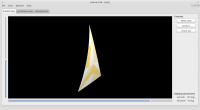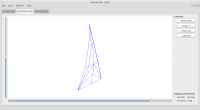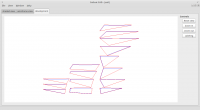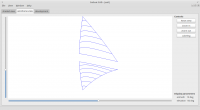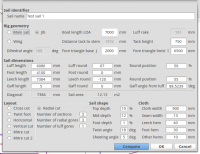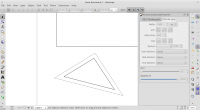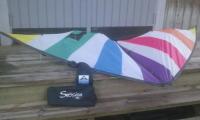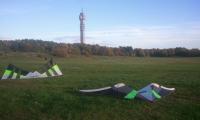-
Posts
580 -
Joined
-
Last visited
-
Days Won
27
Content Type
Profiles
Forums
Gallery
Downloads
KL Shop
Blogs
Articles
Everything posted by Exult
-
Slack line DLK tricking - Many leaps forward required, almost without bounds . Good luck!
-
Thank you - I always enjoy a good story. Usually I'm the one who recommends to have different kites to learn tricks on, on what ever kite that is most prone to to do the trick in your hands. It also gives some more angles to experience than just what one kite can give IMO. However, now might be a good time to stop acquiring and start to explore the characteristics of each kite before the next purchase. Give it time to see what is not covered in the set that you got and be really prepared for the decision of your next kite purchase. Perhaps you then discover a missing wind range in your current set, find a size you would like to experience, have learnt much about a certain model, saved up for a high quality one... Of course you are not going to get that "talking out of" here ! The following was true until very recently, the only kite that ever made me laugh loud is my Fazer XL. Used in a bit high and gusty high wind it is like a happy mad calf. It is reasonably trickable (though not sold as a trick kite), got a really large over steer (which is not the case of the Fazer XXL for some reason) and a gust might make you suddenly end three steps down wind. The kite is robust, so that higher wind when in the air you don't fear that it will break. Tip stabbing is another issue, then the robustness, the higher wind you are prone to choose for this kite and the mass of the kite becomes its enemy. When a LLE of the Fazer XL broke I reinforced the inside of the new tube by gluing a carbon fibre rod where the previous one had broken. Unfortunately I have no experience of the Fazer (called std.?) to share. Could only guess that it could be fun to try in high wind. Guessing anything when it comes to turns would be difficult, since the XL and XXL appear so different here. The second time I can recollect that a kite made me laugh was with my Infinity, when reaching a break through recently - more or less suddenly during a session, several flick flacks worked! And just before going home making a last attempt I managed four cycles and then exited from the fade and flow off. I couldn't believe that it was me and laughed out loud (there was fortunately no one to hear me or else they would have drawn the conclusion that there is a nutcase on the field). Why am I telling you this example here (in a sense hijacking the topic)? To show that this was only a minor part of the story, to show the long term pleasant work of learning to pilot the kite: When returning to kiting soon three years ago "the flying had changed", the fade seemed to be some sort of starting point or at least very common. I had never done a fade (on purpose) before. In hindsight, to get to the flic flack a long time three step process (and the flic flacks has never been the only goal) was required: To learn and to learn to hold the fade. Found it lightly annoying that others seem to be quicker at learning this - this was actually good. Even though you wouldn't have any kiters around, if you can find someone that present a video of flying that is rather close to your level you can then chose to "race" against it. To let go of that your flying always need to look good - Hey, you need room for learning! Constantly be around those positions/situations where you want to learn and reduce the frequency of the parts that are already familiar to you. To myself I called it "tricking en masse" - an observer would probably have said "just tumbling around". Reconnect to the flares I already knew how to do since a long time ago, but in the flic flack context. Yes, once again the feet stopped moving forward when lightly popping the flare to start the transition to the fade, just as they did a long time before when learning other tricks involving a flare. Sounds like learning is a lot of work? Yes and no, because it doesn't really feel like work. Also the process was not as focused as described above - one can work on several things in a more or less parallel way. In spirit of the above example, but in your way, making your story: I wish you both long term and short term kiting happiness and above all I wish you welcome here!!!, Exult
-
The Home > Kite Design > Bridling as well as other stuff in Ian Newham's Site ( http://www.iannewham.com/kitedesign/bridling.html ) was really a nice reading. Clear, pedagogic and well structured. I'll give you the a short description of the article (below), for the purpose of luring you into reading it and to discuss the contents. Also next time travelling, why not instead of killing time with your phone, bring a cord or two and practice the knots from the knot section and memorize the rules of thumb! The text raised, however excellent, two questions: How can these two sentences be true at the same time?: "low and wide is good for roll-ups and other pitch tricks" and "a light nose forward bridle makes flic-flacs (fade/flare) easier". Isn't a flic-flack a pitch based trick? You can't move the POI forwards and backwards at the same time (OK the word "wide" increased complexity somewhat). In the section "Bridle Effects on Pitch Tricks", moving the tow points (=POI?) towards the spreaders (=low/backwards?) requires the towpoints to be moved out. Why? - Not to have immense oversteer? Not mentioned is the effect of a deep vs a shallow bridle (but I'm quite happy with what I got from the article anyhow). Bridling Abstract (of Ian Newham's article) Pre Intro and Footer Nice perspective to make a time-less article (or rather aware if the time). The IMO excellent contents is under some share alike licence. Introduction Good (and humble) terminology walk through. Point of Influence and Feel Intruding the concept of "point of influence" (POI) and giving a intuitive turntable simile of the effect when moving that around. Also relate shifts along the three bridle legs to: beginner kites, "current" French style and late nineties British kites. Knots Use and images of: Larkshead, Locked larkshead, Prussik, Sheet bend, Overhand knot, Double overhand knot, Double overhand knot cinched up, Pigtail with overhand knot, Pigtail with double overhand knot, Inhaul attached to pigtail with sheet bend, outhauls larksheaded onto inhaul and A common way to assemble a 3 point bridle Rule of Thumb Turbo Bridle Layout, howto description and advice. Directly to the essentials in an easily accessible way. Author's first choice of bridle try. Rule of Thumb Static Bridle Layout, howto description and advice. Directly to the essentials in an easily accessible way. (Three point) French style bridle. Tuning High and low wind bridle tuning - nose back/forwards. Bridle Effects in Slack Line Moves I took the liberty of expressing heavy setting and light nose in terms of POI here: POI low and wide: backspins, roll-ups and pitch based tricks in general. POI high: "flick-flacks (flare-fade) POI inwards: "speed up spin tricks like axels and 540s" POI inwards and low: (tip) "stabs and black holes" Bridle Effects on Pitch Tricks Turntable simile again, but here around the LSs. To make a more pitch happy (and back spin) kite move POI towards the LS (i.e. low?). This will require the POI to be moved outward "in order to keep the kite flyable" - cost: turns, axels and flatspins "becomes more sluggish".
-
Well not one rule of thumb but a few instead, but not too difficult or long to follow. A nice bonus is the images of related knots: http://www.iannewham.com/kitedesign/bridling.html I think this page could be suitable for some project aiming at learning about bridle adjustments (and certainly for me it is one of the "ought to learn more of" things).
-
Exactly as I did it. And you can cover a pair of vents to get a mid-vent. Still only have the std and the full vent. But on the other hand, it might not be your way since you seem always have some minimum wind. And if close zero wind happens at some rare occasion, perhaps you have another (non quad) kite for that time? This was really a good feature of my B-series. If they wouldn't have been included I'd still not (knowing myself) would have access to 2 and 4 wrap spars. This has given me the possibility to work on sail loading and controlling the flex. If you are past the panicking and pulling the lines hard close to the ground don't fear breaking the 2 wrap spars. I can much recommend to get frames to be able to meet various wind conditions. You want to be able to curve the LE by pulling the handles to create forward drive. A constantly curved LE in too hard wind or a too stiff LE in light wind that you cannot curve is equally bad. There are some discussions here on other (cheaper and more expensive) spars which I also need to learn more from. Don't know. I picked stuff up here and there on the forum... The process was nice though a bit slow, e.g. I was long confused about long leaders - thought you put them in series with the existing one on the handle... The videos are good though, also for terminology.. So Sweden and nearby countries also seems to be full of them. If I would have known any kiter in Finland I could have gone there on a cheap nice large ferry boat trip (the ferries instead make their living much on tax free and food), but as we all know there is no Finland, https://skeptoid.com/episodes/4573 . I daily see hoards of kiters here that I can exchange valuable information with. Likewise I get valuable experience before purchases by testing their gear ...No, I've not seen any non beginner multi line (DLK and QLK) pilot during this millennium with the exception of power foils. The only two framed quads that I've ever seen are my own. Perhaps the situation is different on the Swedish west coast?
-
Thank you for that piece of advice - just need to locate the one remaining aluminium budget carabiner at home. Could also serve as a bit far fetched argument to get more kites (to add necessary weight to the kite bag...)... Was thinking, perhaps one can do without any stake here. Drive a part of the kite into the snow at an angle towards the wind and then use the handles to pull it lose from the snow back into action. However if there happen to be an ice crust on the snow, the any mesh panels might be damaged? For the B-series standard (non vented) at least I guess one could let the snow only hold the non meshed rear panels - not the LE.
- 212 replies
-
- tips
- san francisco
- (and 4 more)
-
Climate/weather considerations regarding the longevity of your kites Old rain = mud, and will get your kite dirty, dry conditions or new rain will remove dirt. Flying on a thick enough layer of soft snow - there are no limitations in handing over to a beginner - they can't crash it except for snapping the stand offs if the kite get stuck (no no why are you looking at me? ). Abrasion get much reduced on icy ground, but you might suddenly damage a split nock if you happen to tip stab or 2 point-land hard. Is it possible to damage an QLK LE end cap by tip stabbing on hard and/or frozen ground? Salt water - exotic matter occasionally encountered when travelling. Must admit that I went soft though and did dry my f/v 1.5 B-series and my Infinity (but without removing the mud) after my latest session. OMG I suddenly realize, will I be able to drive the (QLK) kite stake into the ground during the whole forthcoming winter (and if so would certain conditions require a metal detector to find the handles again?)? It will be my first winter as a QLK pilot so I haven't had to deal with this issue before and when handling a single DLK in everything except for very hard wind, a kite stake is not so important.
- 212 replies
-
- tips
- san francisco
- (and 4 more)
-
List of free (as in beer at least) CAD software 48 free as of Sun Nov 19 09:17:01 CET 2017 (48 because LibreCAD at the top of the page wasn't included in the 47 item list): https://alternativeto.net/software/caduntu/?license=free Sailcut CAD Mainly for sewing sails, but a wing geometry can perhaps offer some comfort. Handles camber of a sail (3D i.e.) and provides the flat (2D) panels. http://www.sailcut.com/handbook/en/ Choose basic panel layout. OK panels can't be chosen absolutely freely, especially in wing rig geometry. If you feel artistically limited by this you could try to circumvent by assembling a panel by flat sub panels outside the program I assume. Chose the width of the seam and hem. Mould the 3D shape of the sail or set it to flat if you want to stay 2D (but then loosing the main feature of the program - close to pointless). Print (to file?) - each panel gets one page. Coordinates are included. Once it is printed to a file, how to print each panel 1:1 if it would be larger than an A4 (or letter), is a separate problem. E.g. Pdfposter (Linux only?) could split and resize each panel: "Pdfposter can be used to create a large poster by building it from multiple pages and/or printing it on large media". An alternative would be to export it to another of the several available formats and then use some other method to print it. Questions? Sorry I just quickly tried Sailcut CAD out - never really sewn anything sail like in rip stop (except for a very small parachute as a child). Inkscape Vector drawing tool. Native format is svg, but can handle a lot of formats including pdf, at least one page at a time. I really recommend Help > Tutorials. The tutorials are just svg-files that you edit according to the instructions in them. Svg can be included in html, contain links and be edited with a text (or XML) editor. Triangle with outset. Also see: https://inkscape.org/en/ http://kitelife.com/forum/topic/7799-team-kitelife-logo-contest/?do=findComment&comment=63448 https://www.w3schools.com/graphics/svg_intro.asp (Sort of) instruction for drawing one panel and adding an outset: Draw a polygon corresponding to a panel, either by the line tool or by creating a shape (a rectangle, a letter...) and then convert it to a path (Path > Object/Stroke to path). Create a polygon path corresponding to the panel, either by the line tool (shift + F6) or by converting a shape (e.g. a rectangle, a letter...) to a path. Press F2 to edit the nodes of the path. Duplicate the path by selecting the path and press ctrl-D. This makes an overlapping copy of the path. Create the seam/hem width by using the outset function "ctrl-)" or by Path > Outset . It is possible to change the stroke of one of the paths to a segmented line if you think it makes it clearer by the Fill and stroke dialogue (shift+ctrl+F). sailDrawing.pdf
-
The actual posting event of the mostly offline written contents of my previous post wasn't very calm and therefore the resulting text was thereafter: In this topic of Welcoming I rudely missed out the obvious: Welcome here @Justin2kites !!! Instead of stuttering chunks of redundant text as a reply to: I really meant: Get into stalling and barely flying as a start for tricking and have a look on the several getting-into-DLK topics here. Good general kiting luck!
-
"only dual line"? There is so incredibly much to learn - even after (...quickly adding active vs. passive years...) five years. "only dual line"? There is so incredibly much to learn - even after (quickly adding active vs. passive years) five years. And tricks are not everything, consider precision and tempo changes. Abandon the hope approach - seize the opportunities instead. E.g. without having any changes in life, living and work I was able to increase the number of sessions when I "discovered" the pre-work sessions. Another insight that has increased the number of sessions is that almost no matter the weather conditions (except for thunder, hurricanes, heavy rain combined with no wind and hailstorms where the individual hail pellets are large), there is always some skill to practice. I realize that this might not be everyone's cup of tea (especially not if and when learning the basics) - enjoy it in your way! I also had an important video when returning to kiting ( https://www.youtube.com/watch?v=yvUJ9bxB0Gc), but can't claim that I wouldn't have walked the path without it, but it still serves as an inspiration and goal.
-
Congratulations, hope that you have understanding people around you that knows in detail what to give a kiter. ...naahh, that is probably a slim chance that they would find the exact right one. Better doing it yourself - you have deserved a new one you know. Nice card crafting b.t.w.!
-
As can be seen in this image of my oldie HQ Jam Session, winning the Jammin' kite would clearly fill a hole in my kite life...
-
Or another possibility (it's likely that you already considered it though). Reuse a winning design and make the panel/colour design quite similar to the Kymera, though the kites might be very different from each other. It has been done before, think e.g. (preferably the classic look/version with a non colourful LE): Tramontana, Babytana and Maestrale http://www.schreibweis.de/_alt/web/Kiting/zweileiner.htm
-
Arrrg..., see what you have done! The above conversation made me look up "tetra kite" and now I'm thinking (and rethinking, again and again) how I'd like to implement one (and I'm not really into kite building and certainly not SLKs). Yet another thing to add to the todo list to be performed in some fuuuuuuture... On the other hand following the instructions in "My best kite (.com)", "Making Tetrahedral Kites" as an introductory project looks like a rather quick one...
-
I'd say that when you have nose towards you in high wind it is to reduce pull in the lines. You have more or less given up on stalling the kite then, except for possibly at the edge of the wind window. Last week I did tests with my Infinity to see how far back I could have the nose. With the nose in the rearmost position the turns felt very keen, but it had some difficulties in maintaining height in the beginning of a side slide, so I adjusted the nose one knot towards me (about 0.5cm). The wind? Well the forecast said 4-5m/s.
-
Something to think of. When a nice on field chat opportunity arises, I guess that I have the tendency to drown people in info if they have happened to ask a few questions first...
-
In my opinion (as always) keeping is a good decision - a used kite gives you less back when selling it and different kites are prone to do different tricks (in your hands). Some kite will always be the first kite that you managed a trick on and then you might be able to transfer it to the next kite. But then again I'm prone to keeping stuff (ask my wife). It must be a really hard environment you are flying in for a vinyl end cap to quickly get damaged. Sharp splinters of flint-stone pointing upwards everywhere? Typically you lose the vinyl end caps instead (and that is why I mostly use tape to hold them). On the other hand I've damaged many wing tip nock fittings when landing on hard ground. I've seen end caps crack when putting on a too small cap using force, but that has been very rare. First you do a fade launch with a fancy ending (at 0:46 in the above video) and then you want to learn snap stall and axel? Well OK then, before practicing anything requiring a stall I'd recommend a nose back setting so that you don't need to run forwards to maintain it. It will also be easier to do a stall without too much forward drive (nose towards you in harder wind). Obviously not nose too far back so that it gets much difficult to have the kite going forward. B.t.w. can you already do any form of stalls? - e.g. by making a small 1.5m jump followed by a landing (or perhaps considering this a start immediately followed by landing with the nose always pointing upwards?).
-
I detect a possible pattern: a mythological creature starting with a "K". Is it so that you prefer to have a panel design/colour similar to the Kymera? I don't say that they are really close, but the red suggestion somewhat reminds me of my 4D. I assume that white is common for indoor/low wind kites(?), since for some reason white is the first colour that I think of. If it is so it should make sense to go against this and really increase the ratio of "colour colour" to white colour. However think of the visibility of the kite against various backgrounds (bright wall, dark wall, opening and outdoors zero wind night) in a worst case dim illumination, so it remains functional under many conditions. B.t.w. I know of another mythological creature starting with a "K" that happens to be wind related. (Ysätters) "Kajsa" is a Swedish regional wind troll. She likes to play tricks on people and cause other mischief as well ( https://en.wikipedia.org/wiki/Ysätters-Kajsa ). These properties are hardly a selling point, so it would be unlikely that you would change your mind here regarding the name I believe.
-
Thinking of it, "The Pixie" (some kind of a fairy) also sounds light and even more positive than a fairy fairy to me.
-
I was thinking of going on with mythological creatures (such as the Kymera), but of some less fierceful nature, something like The Siren or the Fairy.
-
Would you like to have suggestions for a name? If so, would a separate topic for name suggestions be something?
-
That would be interesting. For me any comparison with your 1.5 B-series would be easier to relate to (but I realize that others would benefit from other comparisons). Take your time. Pretty much any observation would widen my horizon.
-
Is it also some difference when sewing and when otherwise making a kite?
-
I don't know what to say here - errr... Welcome to the bright side (of (DLK) life)? To illustrate that inner hesitation(/richness?) I provide this photo of a recent session of mine. I must have been out of DLK form here - for some reason I forgot to move the Hydra nose from me (i.e. didn't trim the bridle to compensate for the wind) in the rather hard wind. So, for the periods when wind was harder I went for the full vent and in the times between when the wind was lower I used the Hydra instead.
-
From the album: Exult's Photos
The decision was made the evening before (last Thursday) - there had not been so much kiting recently, but there was almost no wind expected for this morning. It was time for the Prism Vapor un-boxing event with the extra bonus of getting a low wind kite that matched the forecast. I was lucky - the kite was OK. I had long put it off because I was not 100% sure that I wasn't going to sell it (allowing me to buy at more modern(?) low wind kite). The only thing I didn't see was an indoor solid carbon rod second top spreader that was mentioned in the instructions. I assembled the kite once in the evening before to practice. The following morning there was a layer of frost on the ground. When coming to the field there were almost constantly someone taking photos of the morning ground fog. The wind, if any, could come from any direction but was maximum about 0.5m/s. I choose the 15m 25kg lines. Compared to my other low wind kites, the Prism 4D and the HQ Shadow, I'd say that this is the one that requires the least effort when doing a 360. When doing an axle with this large light kite, I had to take care to give slack not to prevent it from completing the revolution, even in this almost non-existent wind. In the image the back of the kite is shown - that's why the "spars" appear warped. In the humid environment with melting frost, on the clear panels of the vapor water condensed giving them misty look. The kite got all wet and so did my shoes. The now heavy shoes never dried during the following working day but it was very much worth it. And what about Batman you may ask. Well look carefully under the Kaknäs tower - he is approaching through the mist.




